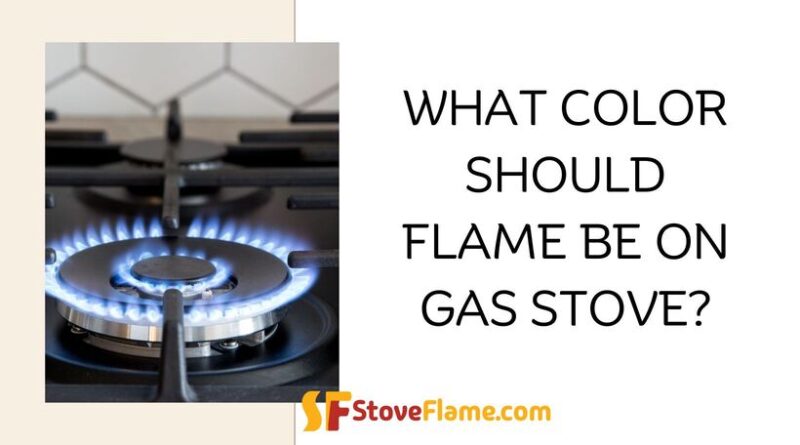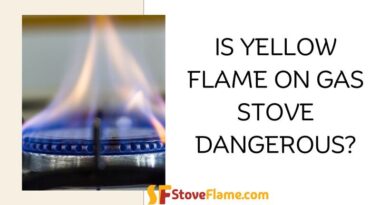What Color Should Flame Be On Gas Stove?
When it comes to using a gas stove, one important aspect to consider is the color of the flame. While many may not give much thought to this, the color of the flame can actually provide valuable information about the efficiency and safety of your gas stove.
As a professional in the gas stove industry, I have encountered numerous questions and concerns from customers about the ideal color of the flame on their stoves. With various factors such as gas type, air flow, and burner adjustments affecting the flame color, it can be confusing for homeowners to determine what is considered normal and safe.
In this article, we will delve into the science behind gas stove flames and discuss the ideal color that should be achieved for optimal performance. By understanding the significance of flame color, you will be equipped with the knowledge to ensure their gas stoves are running efficiently and safely.
Why Gas Stove Flame Color Matters?
One important reason why gas stove flame color matters is because it can indicate the efficiency and safety of your gas stove. A properly functioning gas stove should have a blue flame with a yellow tip. This blue color indicates that the gas is burning efficiently and producing the right amount of heat. If the flame is mostly yellow or has a flickering or uneven pattern, it could be a sign of a problem.
A yellow flame may indicate incomplete combustion, which can lead to inefficient burning and the release of harmful gases like carbon monoxide. Keeping an eye on the flame color and making sure it remains blue can help ensure that your gas stove is operating safely and efficiently.
Understanding the Different Flame Colors
Understanding the different flame colors on a gas stove is essential for maintaining a safe and efficient cooking environment. While a blue flame with a yellow tip is the ideal color, it is also important to be aware of other flame colors and what they may indicate. A predominantly yellow flame could signify a lack of oxygen or a problem with the burner, resulting in incomplete combustion and potential safety hazards.
On the other hand, a white or orange flame may indicate a blockage in the gas line or burner, which can impact the stove’s performance. By being attentive to the flame color and promptly addressing any abnormalities, you can ensure the proper functioning of your gas stove and minimize the risk of potential issues.
Factors That Affect Flame Color
Several factors can influence the color of the flame on a gas stove, providing valuable insights into the combustion process. One significant factor is the ratio of oxygen to fuel. With an adequate supply of oxygen, the flame tends to burn bluer, indicating efficient combustion.
However, if the oxygen supply is limited, the flame may appear more yellow or orange, suggesting incomplete combustion.
Another factor that affects flame color is the type of fuel being used. Different fuels, such as natural gas or propane, can produce slightly different flame colors. Additionally, the cleanliness and condition of the burner can play a role in flame color.
A clean and properly maintained burner is more likely to produce a consistent blue flame. By considering these factors and ensuring proper ventilation and maintenance, you can help maintain a safe and efficient gas stove with the ideal flame color.
What Color Should Flame Be on Gas Stove?
When operating a gas stove, it is essential to pay attention to the color of the flame as it can provide valuable information about the combustion process. As we discuss above, A healthy flame on a gas stove should typically be blue in color. This bluish hue indicates that the combustion is taking place efficiently, with an optimal ratio of oxygen to fuel.
If the flame appears yellow or orange, it may suggest incomplete combustion or a lack of sufficient oxygen supply. In such cases, it is crucial to check for any obstructions in the burner, ensure proper ventilation, and clean the burner if necessary. Regular maintenance and upkeep of your gas stove will help ensure a safe and efficient cooking experience.
Flame Colors for Different Gas Types
Different types of gas used in gas stoves can produce flames of varying colors, providing specific indications about the combustion process. For example, natural gas typically produces a blue flame, while propane may produce a bluish-green flame. However, it is essential to note that the color of the flame can also be influenced by factors such as impurities in the gas supply or a poorly adjusted burner.
Therefore, it is always recommended to consult the manufacturer’s guidelines and seek professional assistance if you notice any unusual flame colors or patterns on your gas stove. Remember, prioritizing safety and regular maintenance is key to ensuring the optimal performance of your gas stove.
Tips for Adjusting Flame Color
To ensure the ideal flame color on your gas stove, there are a few tips you can follow.
Firstly, if you notice a yellow or orange flame, it could indicate incomplete combustion or a problem with the air-to-gas ratio. In this case, adjusting the air shutter near the burner can help achieve a bluer flame.
Secondly, keep the burner ports clean and free from debris, as clogged ports can disrupt the combustion process and lead to inconsistent flame colors.
Additionally, if your stove has adjustable gas pressure settings, make sure it is set to the manufacturer’s recommended level for optimal flame color.
Lastly, regular maintenance and inspections by a professional can help identify any underlying issues and ensure the safe and efficient operation of your gas stove. Remember, a well-adjusted flame not only enhances cooking performance but also promotes safety and energy efficiency in your kitchen.
Signs of a Dangerous Flame Color
When observing the flame color on your gas stove, it’s essential to be aware of any signs of a dangerous flame color. A blue flame with a small, steady yellow tip is typically considered normal and safe.
However, if you notice a predominantly yellow or orange flame, it could indicate a potential problem. This could mean that the gas is not burning efficiently, leading to incomplete combustion and the production of harmful carbon monoxide gas.
A flickering or dancing flame, rather than a consistent and steady flame, is also a cause for concern. If you notice any of these signs, it is crucial to have your gas stove inspected by a professional to identify and resolve any potential issues. Your safety and the safety of your household should always be the top priority when it comes to gas appliances.
Conclusion
In conclusion, understanding the color of the flame on your gas stove is crucial for ensuring the safe operation of your appliance. By knowing what to look for and being aware of any signs of a problematic flame color, you can take proactive measures to protect yourself and your household.
Remember that a blue flame with a small, steady yellow tip is generally considered normal and safe, while predominantly yellow or orange flames, as well as flickering or dancing flames, may indicate potential issues. If you ever notice these signs, it is essential to seek professional assistance to inspect and address any potential problems.
I'm Daniel Miller, the proud owner of StoveFlame. With over five years of experience in this dynamic field, I've honed my skills and passion for delivering top-notch quality and accuracy in everything I do.





